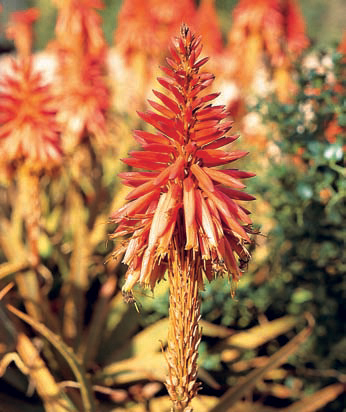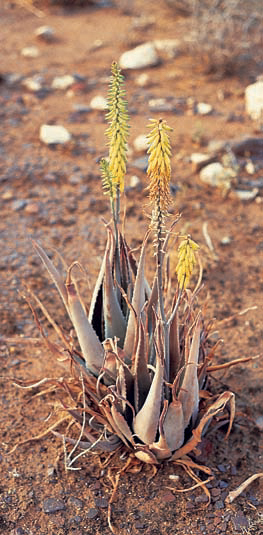

The inflorescences of the East African Aloe camperi are head-shaped and produced in early summer, when few southern African species are in flower.

The bright, inverted cone-shaped inflorescences of Aloe arborescens are a well-known feature of gardens in South Africa’s winter months.
Some Aloe species transcend the boundaries of the broad subdivisions of southern African vegetation types used here and could comfortably be included in any number of these regions. These species can easily withstand, indeed flourish in, a wide variety of climate, soil and topographical types. Almost without exception, they are also the most popular species in amenity and domestic horticulture.

Plants grow as robust shrubs that, over time, form massive, multirosette-bearing clumps. The leaves are soft and easily damaged, typically rather narrow, sickle-shaped and adorned with stiff, but harmless teeth. Leaf colour varies from deep blue-green to a light yellowish green. The inflorescences are made up of a number of candles, each a strikingly beautiful inverted cone shape. Flower colour varies from bright yellow through all shades of orange and red to bright crimson. The species occurs in fynbos in the Western and southern Cape, in eastern coastal thickets, on the subtropical east coast, and in inland grassland and savanna. In cultivation, it is a popular plant for creating a ‘living’ fence or hedge.

This East African species certainly warrants being included here, given how widely it is cultivated in South Africa and across the world. Plants are robust rosettes that sucker from the base. The leaves are shiny green and adorned with white flecks, especially towards their bases. The inflorescences are fairly short and much branched. Flowers are yellow and orange and distinctly club-shaped. Plants thrive under virtually any growing conditions, ranging from deserts to the near-tropics.

These small, stemless plants sometimes form clonal clumps consisting of several heads. The triangular leaves are mostly short, the tips dying back for about one-third of their length. Leaf colour ranges from deep green to dark brown. Leaves are covered in irregular to H-shaped white spots. Inflorescences are single or multibranched, the latter carrying numerous cylindrical flower clusters, varying from dusty pink to deep red. Each flower has a distinct bulbous swelling at the base. Plants occur in the subtropical east coast, grassland and savanna.

Plants typically grow as very large clumps that consist of numerous rosettes. The leaves are very short, almost triangular in outline and beautifully mottled with white flecks. The inflorescences are branched and carry numerous club-shaped flowers, a character not usually associated with maculate aloes. In a dry garden, plants will in time form large cushion-like clumps, flowering freely from late winter into spring. This species occurs in typical grassland, savanna and karroid vegetation.


Plants are mostly small to medium-sized and stemless, but some forms will eventually produce a short trunk covered by the remains of dry leaves. The leaves are usually short and stubby, with distinct dried tips. Leaf surfaces are covered with a profusion of white, H-shaped spots. The inflorescences are made up of short, distinctly flat-topped or, more rarely, rounded candles (racemes). The flowers are quite large, slightly curved and have the distinct basal swellings typical of most spotted aloes. Flower colour varies from golden yellow through all shades of orange and red to crimson. The flowers are often covered with a dense layer of powdery bloom. The species is widespread, occuring in the fynbos, thicket, subtropical east coast, grassland and savanna regions.


Aloe vera is the well known source of leaf sap extracts used in the medicinal and cosmetic industries. It probably originated from the Arabian Peninsula, but is now widely cultivated worldwide. Plants grow as medium-sized to large, stemless rosettes. The light green leaves have scattered white spots on both surfaces and short, stubby teeth on their margins. Leaves are quite soft and can easily be broken off or filleted. Branched inflorescences carry yellow flowers, sometimes tinged with orange, along an elongated stalk. The species is globally known as ‘medicinal aloe’ as a result of its soothing leaf juices, and is often grown as a ready-to-hand first aid treatment for burns and scratches. (See also Uses of Aloes, page 126.)